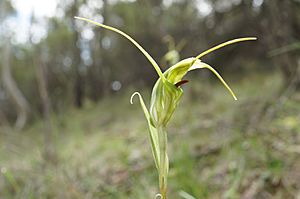Antelope greenhood facts for kids
Quick facts for kids Antelope greenhood |
|
|---|---|
 |
|
| Pterostylis laxa growing on Mount Majura | |
| Scientific classification | |
| Genus: |
Pterostylis
|
| Species: |
laxa
|
| Synonyms | |
|
Diplodium laxum (Blackmore) D.L.Jones & M.A.Clem. |
|
The Pterostylis laxa, also known as the antelope greenhood, is a special type of orchid. It grows only in south-eastern Australia. Like other greenhood orchids, its look changes depending on whether it's flowering or not.
When it's not flowering, this plant has a group of leaves that lie flat on the ground. But when it's ready to bloom, a single flower grows on a tall stem, and the leaves are found on this stem instead. The antelope greenhood has green and white flowers, often with darker green or brown marks. It has a top petal (called a dorsal sepal) that ends in a long, thin tip, like a thread.
Contents
About the Antelope Greenhood Orchid
The antelope greenhood is a plant that grows from the ground. It's a perennial plant, meaning it lives for more than two years. It's also deciduous, so it loses its leaves at certain times. This plant is a herb and has a special underground part called a tuber, which stores food.
When the plant is not flowering, it has a group of 12 to 25 bright green, egg-shaped leaves. These leaves lie flat on the ground. Each leaf is about 0.2 to 1 inch long and 0.3 to 0.6 inches wide.
What the Flowers Look Like
Flowering plants have one single flower. This flower is about 0.7 to 1 inch long and 0.3 to 0.5 inches wide. It usually leans a little bit forward on its stem. The flowering stem can be quite tall, about 8 to 16 inches high. It has three to five leaves growing on it.
The flowers are a mix of green and white, often with darker green or brown patterns. The top part of the flower, called the dorsal sepal, and the petals are joined together. They form a hood, which is known as a "galea." This hood covers the central part of the flower, called the column. The dorsal sepal has a long, thread-like tip that is about 0.3 to 0.7 inches long.
The side sepals (called lateral sepals) stand upright or bend backward. They stay close to the galea. These sepals also have long, thread-like tips, about 1.2 to 1.4 inches long. At their base, they have a flat area with a small dip in the middle.
The "labellum" is another part of the flower. It's about 0.4 to 0.5 inches long and 0.08 to 0.16 inches wide. It's dark in color, curved, and pointed. You can see it sticking out above the dip in the sepals. These orchids usually bloom from January to April.
How it Got its Name
The Pterostylis laxa was officially described for the first time in 1968. It was named by a person named John A.P. Blackmore. He found a sample of the plant in the Upper Grose Valley. The description was then published in a magazine called The Orchadian.
The second part of its scientific name, laxa, is a Latin word. It means "loose" or "slack." This is called the specific epithet.
Where the Antelope Greenhood Lives
The antelope greenhood grows among grasses. You can find it on slopes in forests. It lives in north-eastern Victoria and in eastern New South Wales. Its range goes as far north as the Northern Tablelands.

